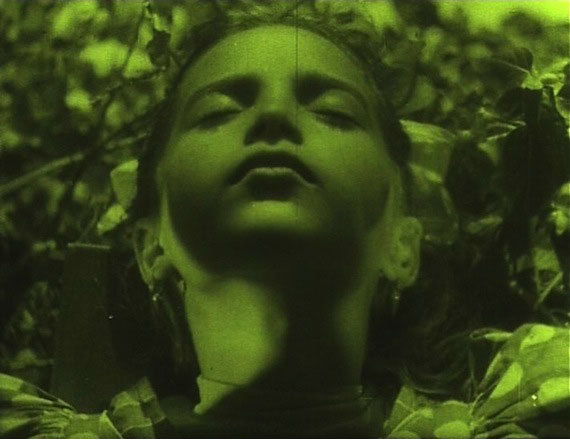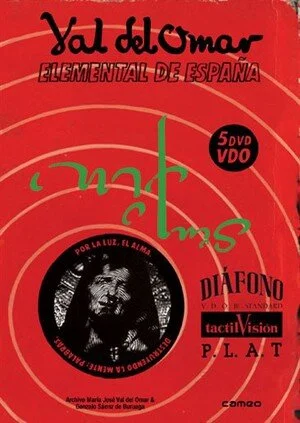VAL DEL OMAR: ELEMENTAL DE ESPAÑA
José Val del Omar was one of the most significant figures of Spanish avant-garde cinema, a contemporary and comrade of Federico García Lorca, Luis Cernuda, María Zambrano and other figures of the Silver Age of Spanish culture, interrupted by the Civil War, that formed the Generación del 36 (Generation of ’36). He was an accomplished creator -- poet, musician, researcher, inventor and proponent of cinema. He defined by himself as a cinemista, or cinema alchemist.
José Val del Omar
The Deluxe Limited Edition boxed set VAL DEL OMAR: ELEMENTAL DE ESPAÑA is dedicated to the works of this unique solitary artist José Val del Omar (1904-1982). The collected works of José Val del Omar have been fully remastered for this important digital publication. Extras include numerous photos and essays by Omar that complement his moving image work. Also included is a 44 page bi-lingual printed booklet, in Spanish and English, with an introductory article by Gonzalo Sáenz de Buruaga, detailed credits for each of the films, and comments from the contributing filmmakers.
UM 'HOME MOVIE' DE 1938 DE JOSÉ VAL DE OMAR. . "PELÍCULA FAMILIAR IS A FAMILY ALBUM IN MOTION. IT SHOWS THE DIRECTOR'S FONDNESS FOR PORTRAITURE, HERE CONTRASTED WITH HIS FASCINATION WITH CERTAIN ENERGETIC OR HONEST FACIAL EXPRESSIONS. AS A FINAL KISS - BARTHES' PUNCTUM - INTIMATE AND INDESCRIBABLE."
Jose Val del Omar has often been considered an essential figure of Spanish experimental cinema. However, Val del Omar can be seen as a key figure of international experimental cinema. This is not a minor point, as displacing Val del Omar from a narrow national narrative is a chance to relocate him within an international constellation of referents. He is part of a global history of images and sounds, connecting his works with some key episodes of the history of cinema. He is the bridge between the 1920s avant-garde and the new underground filmmaking of the 1960s.
P.L.A.T. (Picto-Luminic-Audio-Tactile) Essays by Val Del Omar
Val del Omar believed in a total cinema where the viewer was completely involved in the film and which touched all the senses, a kind of tactile vision, an aspect of ”pure cinema” of the French avant-gardists of the 1920s. When Val del Omar was in Paris in 1921, he was greatly impressed by the milieu of the Parisian avant-garde (CINÉMA DADA), where cinema was discussed as a sensory experience. Some of these ideas were born out of the French impressionist cinema that he discovered in Paris in the early 1920s (particularly thanks to Marcel L’Herbier). Just as Germaine Dulac envisioned a “pure cinema” based solely on movement and rhythm, Val del Omar understood cinema as a non-narrative cinematographic experience composed of both visuals and sound.
In the 1930s he was back in Spain, working as a cinematographer, projectionist, and photographer for the “Pedagogical Missions” sponsored by the liberal Spanish Second Republic. This State project aimed to bring culture, and particularly cinema and photography, to rural areas. The Misiones Pedagógicas, made him realize the potential of film to be used as an instrument to spiritually elevate and improve people’s lives, a kind of mysticism, inspired by the Spanish Baroque architectural style. Val del Omar’s works within the Missions already saw his first technical inventions, such as the zoom. He believed in the immense power of film to create unity between all individuals by means of a spiritual ecstasy, a kind of mysticism.
Two images from Val del Omar's FUEGO EN CASTILLA (1958-60)
Over the course of his career, he experimented with various immersive cinema techniques that presaged the development of stereophonic sound, wide-screen processes, 3D, and expanded cinema. During the last years of his life, after the death of his wife, he becomes practically an ascetic. In Madrid he moves to a basement where he builds PLAT: Pictórico-Lumínico- Audio-Tactil, in other words, his lab, the place to put into practice all his filmmaking experiments.
He applied such technical developments in his masterwork ELEMENTARY TRIPTYCH OF SPAIN. Shot between 1953 and the mid-1960s, this film is without a doubt the most ambitious project in Spanish cinema history and one referred to by Amos Vogel in Film as a Subversive Art as “an explosive, cruel work of the deepest passion... nameless terror and anxiety...one of the great unknown works of world cinema.” The triptych is a series of three "elementales" (the name would translate as "elementary"), which Val del Omar proposed as a cinematic genre distinct from the documentary. Parts of the triptych won awards at the Cannes, Bilbao, and Melbourne film festivals in the late '50s and early '60s before disappearing from view for decades.
AGUAESPEJO GRANADINO (1953-55) — José Val del Omar
AGUASPEJO GRANADINO (1953-1955), with the primary power of its fountains and the immortal aura of the Alhambra, demonstrated two inventions that produced enveloping experiences: a system of lenses by means of which the film goes beyond the screen to colonize the entire projection room and the peripheral vision of the spectator, and Diaphonic Sound, a particular system of binaural stereo divided into one channel for the scene’s natural sound (flowing from the screen) and another for a soundtrack aimed at the viewer’s psyche, rumbling from the back of the projection room to maximize the all-encompassing experience. Both techniques were devised in the forties and fifties, years before Gene Youngblood wrote his foundational Expanded Cinema, or another total scientist-visionary-filmmaker, Stan Vanderbeek, unknowingly a kindred spirit of Val del Omar in more ways than one, began his activity.
Val del Omar’s persistent exploration of the sensory potential of cinema would also connect him to the American experimental avant-garde of the 1960s and 1970s, and filmmakers such as Stan Brakhage, Maya Deren and Marie Menken. For example, Val del Omar’s ELEMENTARY TRYPTIC OF SPAIN includes the use of black and white negative reversal (Peter Kubelka), as well as the oscillation of light and darkness, of presence and absence (Tony Conrad and Paul Sharits).
ACARIÑO GALAICO (DE BARRO) (1961, 1981-82, 1995) — José Val del Omar.
This boxed set also features a selection of films inspired by Val del Omar. They include Eugeni Bonet's experimental feature THROW YOUR WATCH TO THE WATER (2004), which employs Val del Omar's spectacular late color footage, forming a meditation on time and the landscape of Andalusia, as well as VAL DEL OMAR LABORATORY, a 2010 video made by Javier Viver that documents Val del Omar's technological innovations with extensive footage filmed in his still-existing workshop. The closing sentence of all of Val del Omar’s films, reads “sin fin,” or “without end,” instead of “the end,” underscoring a life that is perpetually dedicated to cinematographic experimentation and invention.
Contents
Format: DVD-PAL / Region 0
(No Regional Code); DVD/DSL Bundle
----------------------------------------------------------
WATER-MIRROR OF GRANADA (AGUAESPEJO GRANADINO)
(Spain, 1953-55)
Director: José Val del Omar
• 21 minutes.
• 35 mm
• B&W, color
• Diaphonic sound
◊
VIBRATION OF GRANADA (VIBRACIÓN DE GRANADA)
(Spain, 1935)
Director: José Val del Omar
• 20 minutes
• 16mm
• B&W
• Silent
◊
SCENES (ESTAMPAS)
(Spain, 1932)
Director: José Val del Omar, and other “missionaries.”
• 13 minutes
• 16 mm
• B&W
• Silent
◊
HOME MOVIE (PELICULA FAMILIAR)
(Spain, 1935-38)
Director: José Val del Omar
• 8 minutes
• 16 mm
• B&W
• Silent
◊
FIRE IN CASTILE (FUEGO EN CASTILLA)
(Spain, 1958-1960)
Director: José Val del Omar
• 17 minutes
• 35 mm
• B&W, color
• Diaphonic sound
◊
CHRISTIAN FEASTS – SECULAR FEASTS (FIESTAS CRISTIANAS – FIESTAS PROFANES)
(Spain, 1934-1935)
Director: José Val del Omar (In the section on the Holy Week in Cartegna, Val del Omar worked with filmmakers Rafael Gil, Gonzalo Menéndez Pidal and Cecilio Paniagua)
Production: Culture Department, Murcia Region, 2004
• 51 minutes
• 16 mm
• B&W
• Silent
• Recorded sound version, music by Alejandro Massó
◊
GALICIAN CARESS (OF CLAY) (ACARIÑO GALAICO (DE BARRO))
(Spain, 1961, 1981-82, 1995)
Director: José Val del Omar
Assistant Director: Anric Massó
• 23 minutes
• 35mm
• B&W
• Sound
◊
ELEMENTARY TRIPTYCH OF SPAIN (TRIPTICO ELEMENTAL DE ESPAÑA)
(Spain, 1996)
Director: José Val del Omar
• 61 minutes
• 35mm
• B&W, Color
• Diaphonic sound
◊
VAL DEL OMAR SOUTH – NORTH (VAL DEL OMAR SUR – NORTE)
(Spain, 1974)
Director: Mario Sáenz de Buruaga
• 7 minutes
• Super 8mm
• Color
• Silent
◊
OJALA VAL DEL OMAR
(Spain, 1994)
Director: Cristina Esteban
• 55 minutes
• 35mm
• Color, B&W
• Sound
◊
VERTEX VORTEX (VÉRTICE VÓRTICE)
(acceleration trance expansion)
(Spain, 2002)
Concept & Editing Director: Antonella La Sala
Production: Instituto Cervantes, Madrid
• 12 minutes
• Video
• Color, B&W
• Sound
• A selection of unedited films by José Val del Omar on Super 8 and 35mm.
◊
LABORATORY VAL DEL OMAR (LABORATORIO VAL DEL OMAR)
(Spain, 2009-2010)
Director: Javier Viver
• 60 minutes
• Digital Betacam
• Color, B&W
• Sound
◊
VAL DEL OMAR OUT OF HIS MIND (VAL DEL OMAR FUERA DE SUS CASILLAS)
[Noosphere, Aurora Phase II]
(Spain, 2010)
Coordinator: Velasco Broca & Victor Berlin
• 5 minutes
• 16 mm
• Color, B&W
• Sound
◊
THROW YOUR WATCH TO THE WATER (TIRA TU RELOJ AL AGAUA)
(Spain, 2003-04)
Director: Eugeni Bonet
• 88 minutes
• 35 mm
• Color
• Sound
_________________________________________
Bonus Material
• Pedagogic Missions Photo Gallery
• FIRE IN CASTILE Production Photo Gallery
• ELEMENTARY TRIPTYCH OF SPAIN Photo Gallery
• Collages
• PLAT Essays
• Diakinas
_________________________________________
_________________________________________
Total Running Time: 07:22:09 (5 Discs)
Language: Spanish. English subtitles. Spanish & English menus
Booklet Text: Gonzalo Sáenz de Buruaga (Bilingual Spanish & English)
Published By: Cameo Media
Institutional Price: $600 (plus shipping); $900 DVD/DSL bundle (plus shipping)
To order call: 212.280.8654 or click here for information on ordering by fax, e-mail or post.








